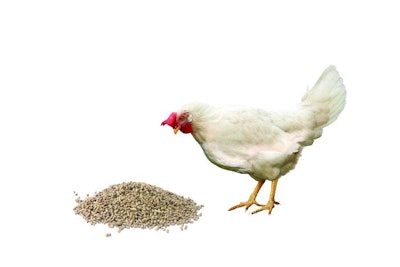
Compound feed production for the poultry industry is thought to have fallen in the EU by 3.4% last year, according to estimates released by The European Feed Manufacturers' Federation (FEFAC) in late October.
The contraction contrasts with the 0.8% expansion thought to have been recorded in 2021, and the industry body attributes this decline to lower demand stemming from outbreaks of avian influenza (AI) across the EU, with France, Belgium, Italy and Hungary being particularly hard hit.
AI, however, was not the only factor that reduced demand for poultry feed in Europe. FEFAC continues that farmers, following increased production costs, for example for feed, energy and packaging in both the egg and meat sectors, postponed production cycles.
Additionally, the EU trade policy offering temporary zero tariff and zero quota access for Ukrainian products, led to significant imports of poultry meat and eggs into the EU in July and August. These imported products have been more attractive than locally produced poultry meat due to inflationary pressures on consumers. High value products, such as free range and organic, have become more difficult to sell.
While demand for compound feed from the poultry industry may have contracted last year, its rate of decline was less than for the industry has a whole.
Overall decline
FEFAC estimates suggest that total compound feed production declined by 5 million metric tons (MT) to stand at 145 million MT in 2022, a decrease of 3.5% year-on-year.
Output is thought to have declined the most among the larger producing countries, with estimates suggesting year-on-year contractions ranging from 8.8% to 1.5%, reflecting supply chain disruptions and the spread of animal disease.
Only feed manufacturers in the Baltics, Ireland, Poland, Bulgaria and Slovenia are thought to have maintained feed production at a level similar to that recorded in 2021.
Like all industries, feed manufacturers in the EU have been suffering from inflation and, in September, FEFAC warned of the growing risk to the survival of a number of small- and medium-sized compound feed and premix manufacturers.
Other species
Feed production for the pig industry is thought to have been the hardest hit last year, with estimates suggesting a contraction of 5.6% compared to 2021. This reflects reductions in herd sizes in some Member States, or farmers leaving the industry.
The contraction in the pig industry has been attributed to increased production costs and animal health issues, such as African swine fever. The situation has been particularly critical in Belgium, where the industry has shrunk by 11%, and in Denmark where the industry has contracted by 9%. Similar figures have been reported for a number of other European countries.
Cattle feed production is thought to have fared rather better than pig and poultry feed, contracting by only 1.3% compared to 2021.
Difficulties to continue
For the year ahead, FEFAC believes that increasing utility costs and economic uncertainty will continue to impact the market. Higher costs linked to environmental and animal welfare policies, along with ongoing disease outbreaks, will also continue to impact the sector.
It adds that a key challenge for the grain and oilseeds market remains the uncertainty over the continuation of the Black Sea Grain Initiative, which allows for significant volumes of commercial food exports from three key Ukrainian ports in the Black Sea and the pace of expansion of EU Solidarity Lanes, established to ensure that Ukraine can export grain, but also import the goods that it needs, to keep Ukrainian exports operational.
EU’s compound poultry feed production closes 2021 higher


















